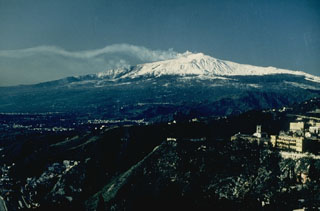Report on Etna (Italy) — 12 March-18 March 2025
Smithsonian Institution / US Geological Survey
Weekly Volcanic Activity Report, 12 March-18 March 2025
Managing Editor: Sally Sennert.
Please cite this report as:
Global Volcanism Program, 2025. Report on Etna (Italy) (Sennert, S, ed.). Weekly Volcanic Activity Report, 12 March-18 March 2025. Smithsonian Institution and US Geological Survey.
Etna
Italy
37.748°N, 14.999°E; summit elev. 3357 m
All times are local (unless otherwise noted)
The Sezione di Catania - Osservatorio Etneo (INGV) reported continuing activity at Etna during 10-16 March. Weather clouds often obscured views of the summit area, though during a few clear periods gas emissions were observed rising from the summit craters. Strombolian activity at SE Crater resumed at 2018 on 15 March with incandescent ejecta staying inside the crater. The Aviation Color Code was raised to Yellow (the second lowest level on a four-color scale) at 2032 and then to Orange at 2047. Activity intensified at around 0000 on 16 March and incandescent material fell onto the flanks as far as the base of the crater. The activity peaked at 0115, began declining at 0215, and ceased at 0320. The Aviation Color Code was lowered to Yellow and then Green at 0841 and 1642, respectively, on 17 March.
Geological Summary. Mount Etna, towering above Catania on the island of Sicily, has one of the world's longest documented records of volcanism, dating back to 1500 BCE. Historical lava flows of basaltic composition cover much of the surface of this massive volcano, whose edifice is the highest and most voluminous in Italy. The Mongibello stratovolcano, truncated by several small calderas, was constructed during the late Pleistocene and Holocene over an older shield volcano. The most prominent morphological feature of Etna is the Valle del Bove, a 5 x 10 km caldera open to the east. Two styles of eruptive activity typically occur, sometimes simultaneously. Persistent explosive eruptions, sometimes with minor lava emissions, take place from one or more summit craters. Flank vents, typically with higher effusion rates, are less frequently active and originate from fissures that open progressively downward from near the summit (usually accompanied by Strombolian eruptions at the upper end). Cinder cones are commonly constructed over the vents of lower-flank lava flows. Lava flows extend to the foot of the volcano on all sides and have reached the sea over a broad area on the SE flank.

